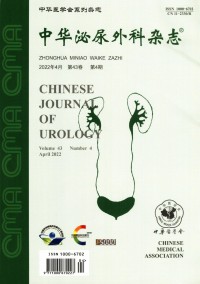Feasibility and safety of tract dilation under ultrasound guidance in standard percutaneous nephrolithotomy
Q4 Medicine
引用次数: 0
Abstract
Objective To investigate the feasibility of tract dilation monitored by ultrasound in percutaneous nephrolithotomy (PCNL), and the risk factors for its failure. Methods A retrospective study was conducted on patients underwent PCNL with only one access (F24) using balloon dilator and sequential dilators (Amplatz and telescopic metal dilators) from December 2014 to December 2018 in Beijing Tsinghua Changgung Hospital. A total of 231 patients (130 males and 101 females) underwent ultrasound-guided PCNL with a mean age of (52.3±9.8) years were included in our study. Mean BMI was (25.8±3.1)kg/m2. Mean size of stone was (3.9±1.1)cm, 51.1% (118/231) of which were staghorn stones. Under ultrasound guidance, after puncture of the target calyx, the balloon dilator was advanced through the guide wire, and inflated to establish the F24 standard renal access. Patients’ clinical parameters such as age, gender, BMI, stone diameter, history of open nephrolithotomy were collected. Risk factors for the failure of ultrasound guided balloon dilation were analyzed by logistic regression analysis. Results Tract dilation succeed in 89.2 % cases (206 succeed, 25 failed) at first attempt. Median tract dilation time was 4.2 min (2.2-8.0 min). Mean operation time was 85.5 min(45.0-120.0 min). Median hemoglobin drop at the first postoperative day was 16.0 g/L (5.0-25.8 g/L). The total rate of complication was 9.1% (21 cases), including 18 cases Clavien Ⅰ and 3 cases Clavien Ⅱ. The stone free rate was 89.6%(207/231). Logistic regression analysis revealed that lower pole access (P=0.014) was a risk factor for the failure of access establishment, while the presence of hydronephrosis of target calyx (P<0.001) would significantly increase the success rate. Conclusions Tract dilation using balloon catheter can be safely monitored by ultrasound with high success rate and low complication rate. Lower pole puncture will make tract establishment difficulty. Patients with a hydronephrotic target calyx are more suitable for this procedure. Key words: Kidney calculi; Percutaneous nephrolithotomy; Ultrasound guidance; Balloon dilation超声引导下肾道扩张在标准经皮肾镜取石术中的可行性和安全性
目的探讨超声监测肾道扩张在经皮肾镜取石术(PCNL)中的可行性及其失败的危险因素。方法回顾性分析2014年12月至2018年12月在北京清华长庚医院使用球囊扩张器和顺序扩张器(Amplatz和套筒式金属扩张器)行单通道(F24) PCNL的患者。本研究共纳入231例(男性130例,女性101例)行超声引导下PCNL的患者,平均年龄(52.3±9.8)岁。平均BMI为(25.8±3.1)kg/m2。结石平均大小为(3.9±1.1)cm, 51.1%(118/231)为鹿角结石。超声引导下,穿刺靶肾盏后,将球囊扩张器通过导丝推进,充气建立F24标准肾道。收集患者的年龄、性别、BMI、结石直径、开式肾镜取石史等临床参数。采用logistic回归分析超声引导球囊扩张失败的危险因素。结果首次扩张术成功206例,失败25例,占89.2%。中位束扩张时间4.2 min (2.2 ~ 8.0 min)。平均手术时间85.5 min(45.0 ~ 120.0 min)。术后第1天血红蛋白中位数下降16.0 g/L (5.0 ~ 25.8 g/L)。总并发症发生率为9.1%(21例),其中ClavienⅠ18例,ClavienⅡ3例。结石清除率为89.6%(207/231)。Logistic回归分析显示,下极通道(P=0.014)是通道建立失败的危险因素,而靶萼存在肾积水(P<0.001)可显著提高通道建立成功率。结论超声监测球囊导管扩张术安全,成功率高,并发症发生率低。下极穿刺将使通道建立困难。靶肾盏有肾积水的患者更适合这种手术。关键词:肾结石;经皮肾镜取石术;超声引导;气球膨胀
本文章由计算机程序翻译,如有差异,请以英文原文为准。
求助全文
约1分钟内获得全文
求助全文
来源期刊

中华泌尿外科杂志
Medicine-Nephrology
CiteScore
0.10
自引率
0.00%
发文量
14180
期刊介绍:
Chinese Journal of Urology (monthly) was founded in 1980. It is a publicly issued academic journal supervised by the China Association for Science and Technology and sponsored by the Chinese Medical Association. It mainly publishes original research papers, reviews and comments in this field. This journal mainly reports on the latest scientific research results and clinical diagnosis and treatment experience in the professional field of urology at home and abroad, as well as basic theoretical research results closely related to clinical practice.
The journal has columns such as treatises, abstracts of treatises, experimental studies, case reports, experience exchanges, reviews, reviews, lectures, etc.
Chinese Journal of Urology has been included in well-known databases such as Peking University Journal (Chinese Journal of Humanities and Social Sciences), CSCD Chinese Science Citation Database Source Journal (including extended version), and also included in American Chemical Abstracts (CA). The journal has been rated as a quality journal by the Association for Science and Technology and as an excellent journal by the Chinese Medical Association.
 求助内容:
求助内容: 应助结果提醒方式:
应助结果提醒方式:


